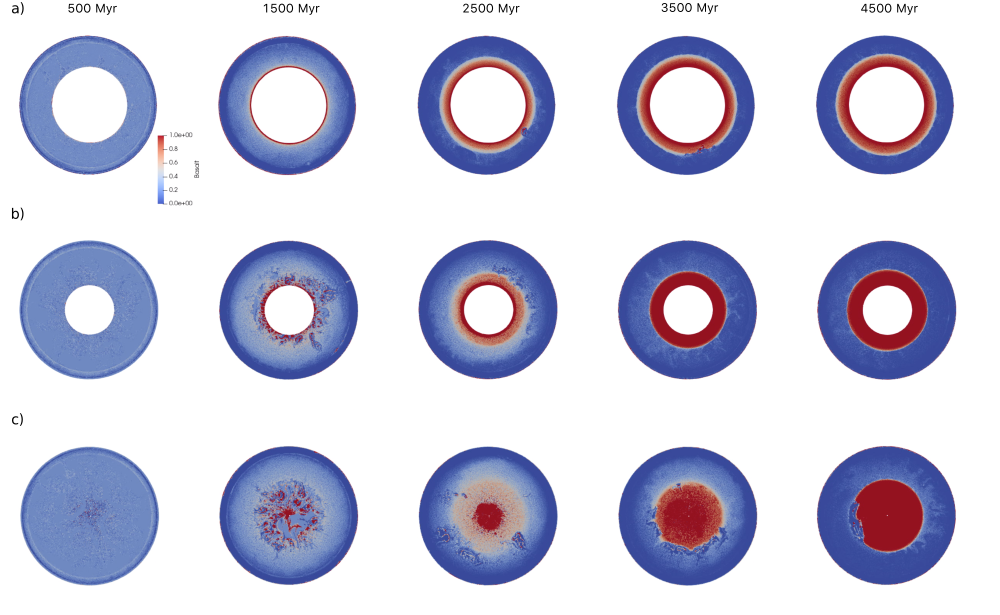Interior dynamics of small-core and coreless exoplanets
- ETH Zurich, Geophysics, Earth Sciences, Switzerland (cahasler@student.ethz.ch)
Since the first exoplanet detection in 1992, the study of exoplanets has received considerable attention. It is becoming apparent that the diversity of the general exoplanet population extends beyond that of the Solar System and includes a variety of structures and compositions. For instance, recent research suggests that if a terrestrial planet forms with substantially more Al and Ca than Earth, it may be entirely rocky and lack a metallic core. Two such planets have been tentatively identified (Dorn et al., 2018).
Small-core and coreless planets are expected to differ significantly from Earth. Small cores may have fundamentally different dynamics compared to larger cores, which can affect the heat flow inside the planet and the generation and retention of a magnetic dynamo. Additionally, core size has been shown to affect the development of plate tectonics in numerical models (Osterloo et al. 2021; O'Neill et al., 2017), as well as carbon cycling on a planet. Investigating small-core and coreless planets therefore illustrates the potential diversity of exoplanets and offers insight into different regimes of mantle dynamics and plate tectonics.
In this study, we use the code StagYY (Tackley, 2008, 2013) to model the evolution of planets with core mass fractions ranging from 10-1 to 10-6 and compare them to an Earth-like reference model. We use mantle reference viscosities of 1020, 1021, and 1022 Pa·s and crustal yield stresses of 30, 100, and 300 MPa. The planets are set to evolve for 4.5 Gyr.
In planets with smaller cores, hot plumes rising from the core-mantle boundary (CMB) are reduced in number and develop slowly compared to large-core planets. In the models with a reference viscosity of 1021 Pa·s and a crustal yield stress of 30 MPa, all planets show subduction and plate tectonic-like behavior. The onset of subduction is delayed in small-core planets compared to the Earth-like reference model. Basalt-enriched material accumulates at the CMB and forms a continuous layer in all planet models; this layer is thicker in small-core planets. Due to insulation by the basalt layer, CMB temperature is significantly higher in small-core planets at the end of the 4.5 Gyr evolution period.
For a lower reference viscosity of 1020 Pa·s, subduction is initiated earlier and the basalt layer surrounding the CMB is thicker, while the reverse is true for the higher reference viscosity of 1022 Pa·s.
At higher yield stresses, some of the planet models undergo subduction and later transition to a stagnant-lid state. However, for a reference viscosity of 1021 Pa·s and a yield stress of 100 MPa, there is no consistent trend regarding this transition. For a yield stress of 300 MPa, planets with core fractions of 10-3 and larger do not show any subduction, but remain in stagnant-lid state throughout the evolution period. In planets with smaller core fractions, subduction events occur starting at 2.5 Gyr. This agrees with previous research suggesting that a small core size can favor the initiation of plate tectonics (Osterloo et al. 2021; O'Neill et al., 2017). In such cases, core size may crucially influence a planet's habitability, since a large-core planet may lack the plate tectonics that are sometimes considered essential to efficient carbon cycling, while a small-core planet may lack the gravity or magnetic dynamo necessary to sustain life.
We conclude that core size influences the onset of subduction and plate tectonics on terrestrial planets, as well as their thermal evolution. Small-core planets tend to initiate subduction later than their large-core counterparts and can also be subject to interior heating due to the hot basalt layers insulating the core. For high crustal yield stresses, small-core planets are more likely to develop plate tectonics, while large-core planets remain in a stagnant-lid state. However, this tendency is not evident at yield stresses below 300 MPa.

Figure 1: Interior differentiation of planets with a) Earth-like core size b) core mass fraction of 10-1 c) core mass fraction of 10-6 for a reference viscosity of 1021 Pa·s and crustal yield stress of 100 MPa.
References:
Dorn, C., Harrison, J. H. D., Bonsor, A. and Hands, T.O. A new class of Super-Earths formed from high-temperature condensates: HD219134 b,55 Cnc e, WASP-47 e, MNRAS, 484 (1), 712–727, doi:10.1093/mnras/sty3435.url:http://dx.doi.org/10.1093/mnras/sty3435, 2018.
O'Neill, C., Lowman, J., Wasiliev, J. The effect of galactic chemical evolution on terrestrial exoplanet composition and tectonics, Icarus, 352, 114025, doi: 10.1016/j.icarus.2020.114025, 2020.
Oosterloo, M., Höning, D., Kamp, I. E. E., van der Tak, F. F. S. The role of planetary interior in the long-term evolution of atmospheric CO2 on Earth-like exoplanets, A&A, 2021, doi:10.1051/0004-6361/202039664, 2021.
Tackley, P. J. Modelling compressible mantle convection with large viscosity contrasts in a three-dimensional spherical shell using the yin-yang grid, Phys. Earth Planet. Inter, 171 (1-4), 7-18, doi: 10.1016/j.pepi.2008.08.005, 2008.
Tackley, P. J., Ammann, M., Brodholt, J. P., Dobson, D. P. and Valencia, D. Mantle dynamics in super-Earths: Post-perovskite rheology and self-regulation of viscosity, Icarus 225 (1), 50-61, doi:10.1016/j.icarus.2013.03.013, 2013.
How to cite: Hasler, C. and Tackley, P.: Interior dynamics of small-core and coreless exoplanets, Europlanet Science Congress 2021, online, 13–24 Sep 2021, EPSC2021-502, https://doi.org/10.5194/epsc2021-502, 2021.

